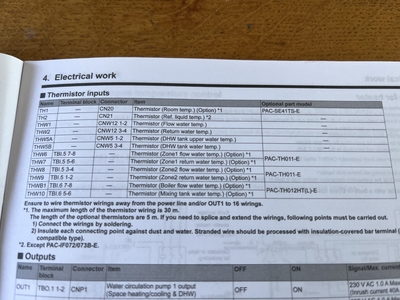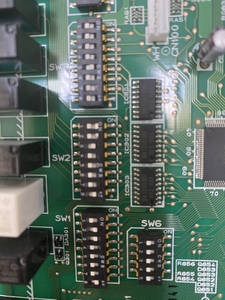Which temperature sensor for a Steibel buffer and Ecodan?
My installer configured our Ecodan 14kW system with a 100 litre Steibel 4-port buffer (surprise) and I have recently had this converted into a volumiser in order for it to work better when in cooling mode (see other thread on rapid cycling when cooling with the old set-up).
Anyway, the buffer has "dry pocket" near the bottom for a temp sensor that uses a 14mm dia thread.
I would like to install a sensor and connect to the Ecodan controller so that it shows up on the temp graphs in iOS MELcloud app as "Mixing cylinder". This line on the graph is currently unused.
I asked Steibel tech support for recommendations but they just said that they didn't supply a sensor and the type needed would depend on the heat pump.
Two questions:
1 what sensor to use that will fit and have the correct wiring
2 where to connect it in the control box.
There are lots of temp sensors with 14mm diameter threads on Google but they mostly seem to be for car engines not heat pumps...
Mitsubishi Zubadan 14kW with Mixergy 210l DHW in 220m2 barn property. 24 solar panels = 9kWp with GivEnergy 5.0kW Hybrid inverter and 19kWh GivE batteries. Jaga Strada fan-assisted rads throughout. Landvac vacuum glazing/triple glazed windows.
@ashp-bobba might be able to help as an Ecodan expert.
Get a copy of The Ultimate Guide to Heat Pumps
Subscribe and follow our YouTube channel!
@downfield I have never added a buffer sensor as we never have used a buffer, I know on many brands you can add them as well as a flow sensor. I would need to look it up for you or you could speak to Mitsubishi and they would tell you which port would work for what you want.
1st we would need to know which FTC you have 5,6 or7?
On the FTC6 it is most likely DIP switch SW2-6 is labelled “Mixing tank WITHOUT / Mixing tank WITH” indicating the controller has a feature for a mixing or buffer tank.
Mitsubishi typically uses 10 kΩ NTC thermistors at 25 °C with a specific resistance/temperature curve.
KR
AAC Group Ltd covering the Kent Area for design, supply and installation of ASHP systems, service and maintenance, diagnostics and repairs.
Professional installer. Book a one-to-one consultation for pre- and post-installation advice, troubleshooting and system optimisation.
@ashp-bobba many thanks for the information.
I have found the manual which has the numbers PAC-IF71B-E -IF2B-E and IF3B-E on the front - not sure what that means.
Anyway there is a table of thermistor inputs (attached) which mentions the Mixing tank on the last row and gives a part number PAC- TH012HT(L)-E for the thermistor.
So if I can get that will I be able to plug it in at the FTC end?
What do I need for the 14mm dry pocket at the volumiser end? will it just screw in?
thanks
Julian
Mitsubishi Zubadan 14kW with Mixergy 210l DHW in 220m2 barn property. 24 solar panels = 9kWp with GivEnergy 5.0kW Hybrid inverter and 19kWh GivE batteries. Jaga Strada fan-assisted rads throughout. Landvac vacuum glazing/triple glazed windows.
@downfield Hi, if it has a 14mm dry pocket you should just be able to insert heat transfer paste and push the probe into it to get a close reading, if you dont have paste or want to use it we recommend inserting the probe at the same time as some armaflex insulation to make sure the probe is tight up against the wall of the pocket. I think the probes for mitsi are around 8mm so it should fit.
All of this can be checked with Mitsi and its worth checking as there are often multiple choices, also you can ask them how to set up the reading and it is likely you will need to turn the power off, change a dip switch or 2 and power back on for it to read.
KR
AAC Group Ltd covering the Kent Area for design, supply and installation of ASHP systems, service and maintenance, diagnostics and repairs.
Professional installer. Book a one-to-one consultation for pre- and post-installation advice, troubleshooting and system optimisation.
@ashp-bobba Re:
"On the FTC6 it is most likely DIP switch SW2-6 is labelled “Mixing tank WITHOUT / Mixing tank WITH” indicating the controller has a feature for a mixing or buffer tank."
I wonder if you could expand on this point, please? I have recently had my buffer tank converted to volumiser, but with a contractor who had very little knowledge of Mitsu equipment and who could get even less support from them.
Are you saying that without a buffer SW2-6 should be Off i.e. "Mixing tank WITHOUT" ?
342sq m "Upside down" house in Algarve. Portugal
Mitsubishi PUHZ-120YUK 16kW ASHP
12 Solar Panels Growatt Inverter
2 x Growatt 7.5kW Batteries
Fronius EV Charger
Kia e- Niro 64kW
@davidalgarve As advised above, its worth speaking to Mitsi as I do not know having never used this function and not fitting buffers. I do not know what will happen with the control logic on the FTC5/6 if it can see an additional probe, it may be that is simply reads it only or that the reading feeds the info back and actually will make the machine try to run in a way that it takes this value into account, considering in most cases the last thing you want is a buffer or mixed load on your system its may not be desirable for the unit to read this probe.
Its just worth speaking to them, and TBH, in my experience they are helpful them techies.
AAC Group Ltd covering the Kent Area for design, supply and installation of ASHP systems, service and maintenance, diagnostics and repairs.
Professional installer. Book a one-to-one consultation for pre- and post-installation advice, troubleshooting and system optimisation.
- 26 Forums
- 2,342 Topics
- 53 K Posts
- 221 Online
- 6,000 Members
Join Us!
Worth Watching
Latest Posts
-
RE: Advice on internal circulation pump noise
Welcome and I am sorry you are having this problem. &...
By JamesPa , 2 hours ago
-
RE: Octopus Cosy Heat Pump Owners & Discussion Thread
@harrisonc mine has level 3 MID monitoring and you can ...
By swwils , 4 hours ago
-

RE: Heat Pump Heats the House… But It’s Not Cosy. Emitter Changes or System Tweak?
@alastair, in short, no, increasing emitter capacity wo...
By Mars , 4 hours ago
-
RE: Setback savings - fact or fiction?
Hi @cathoderay - this is a good discussion! I feel like...
By RobS , 5 hours ago
-

RE: Free Ecoheat Heat Pump Install
@deltona happy to help as much as I can if you decide t...
By bontwoody , 5 hours ago
-

RE: Are We Sleepwalking Into Another Race to the Bottom?
I'll be honest, I love that idea! I'll start working on...
By Mars , 6 hours ago
-
RE: Configuring third party dongle for Ecodan local control
@majordennisbloodnok I think the HPDHD diagnosis may be...
By Sheriff Fatman , 7 hours ago
-

RE: External pipework insulation
I don't think we can tell from a photo whether your exi...
By Transparent , 7 hours ago
-
RE: Controlling Daikin Altherma via P1P2 and Home Assistant
@majordennisbloodnok That’s correct. I can’t find anywh...
By weoleyric , 13 hours ago
-

RE: A Smarter Smart Controller from Homely?
@papahuhu I hope you get a swift resolution. Regards, T...
By Toodles , 1 day ago
-

RE: Poll for Time of Use, tariffs, technology
That’s fine by me too Major, I feel it is a sad reflect...
By Toodles , 1 day ago
-

Bingo. Sometimes a judiciously placed size 10 bovver bo...
By Majordennisbloodnok , 2 days ago
-
RE: Mitsubishi Ecodan 11.2kW heat pump with low COP
@ciocoiu-alexandru I can't provide the same level of di...
By Sheriff Fatman , 2 days ago
-

The three technical issues I'm considering are: BMS...
By Transparent , 2 days ago
-
RE: LiFePO4 lithium battery fires and explosions
@transparent Your post may fit better in th...
By Batpred , 2 days ago
-

RE: British Gas vs Octopus Energy vs Heat Geek vs EDF vs Aira vs OVO vs EON.Next vs Boxt
@jamespawhite, if you could be bothered, you could also...
By Mars , 2 days ago
-
RE: Commencing on an ASHP Installation Process
I've got a bit of time to draft something today, so the...
By Sheriff Fatman , 2 days ago
-
RE: Help with heat pump sizing
@amin I dont think materially relative to t...
By JamesPa , 2 days ago







